|
Mitsubishi Lancer /
Galant Fortis
Debut: 2007
Maker: Mitsubishi
Predecessor: Lancer Cedia
|
|
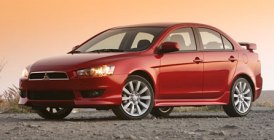 The new, 10th generation
Lancer was conceived when Mitsubishi was still 34-percent owned by
DaimlerChrysler (note: their relationship finally ended in 2004). In
order to enhance economy of scale, the alliance decided it shall be
based on a new global platform sharing with Dodge Caliber, Chrysler
Sebring, Jeep Compass and Mitsubishi's own Outlander – all these cars
are much larger and heavier than the traditional Lancer thus they
require a stronger chassis and bigger engines. As a result, the new
Lancer was forced to grow in all aspects. It is some 35 mm longer in
overall length and wheelbase, 65 mm wider and 55 mm taller than the car
it replaced. Kerb weight has been increased by a massive 200 kilograms,
while the chassis has its torsional rigidity boosted by 56 percent.
This is no longer the compact Lancer we used to know. It is actually
larger than the Galant of two generations back. No wonder in Japan
Mitsubishi calls it "Galant Fortis" instead of Lancer. The new, 10th generation
Lancer was conceived when Mitsubishi was still 34-percent owned by
DaimlerChrysler (note: their relationship finally ended in 2004). In
order to enhance economy of scale, the alliance decided it shall be
based on a new global platform sharing with Dodge Caliber, Chrysler
Sebring, Jeep Compass and Mitsubishi's own Outlander – all these cars
are much larger and heavier than the traditional Lancer thus they
require a stronger chassis and bigger engines. As a result, the new
Lancer was forced to grow in all aspects. It is some 35 mm longer in
overall length and wheelbase, 65 mm wider and 55 mm taller than the car
it replaced. Kerb weight has been increased by a massive 200 kilograms,
while the chassis has its torsional rigidity boosted by 56 percent.
This is no longer the compact Lancer we used to know. It is actually
larger than the Galant of two generations back. No wonder in Japan
Mitsubishi calls it "Galant Fortis" instead of Lancer.
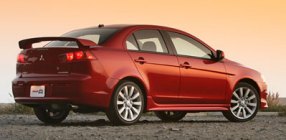 The new Lancer is not only larger but also more stylish.
Its European-style design emphasizes sportiness, especially in GTS trim
which comes with aggressive spoilers and 18-inch alloy wheels. A
V-shape bonnet draws your attention to the huge trapezoidal grilles
which is the most dramatic feature of the car. I have a strong feeling
that its designer must be a fan of Japanese cartoon "Gundam", as its
front end design shows the same design theme as that space-age military
robot. However, as a car the radical front end may have some negative
effects. It is not as tasteful as, say, Volkswagen Golf GTi, nor as
inherently beautiful as Seat Leon. Its attractiveness is likely to fade
with time. Time will tell whether I am right. The new Lancer is not only larger but also more stylish.
Its European-style design emphasizes sportiness, especially in GTS trim
which comes with aggressive spoilers and 18-inch alloy wheels. A
V-shape bonnet draws your attention to the huge trapezoidal grilles
which is the most dramatic feature of the car. I have a strong feeling
that its designer must be a fan of Japanese cartoon "Gundam", as its
front end design shows the same design theme as that space-age military
robot. However, as a car the radical front end may have some negative
effects. It is not as tasteful as, say, Volkswagen Golf GTi, nor as
inherently beautiful as Seat Leon. Its attractiveness is likely to fade
with time. Time will tell whether I am right.
The cabin of the previous Lancer used to be a weak point, no matter in
terms of space, quality or style. Frankly, to improve on that is
probably the easiest job in the world. Mitsubishi didn't take too much
efforts to bring in a more stylish dashboard, decent plastics and more
space all round. Nevertheless, compare with the latest standard of the
class you won't say it is outstanding. It still fails to provide the
quality feel of Volkswagen, Peugeot and Renault. It won't surprise you
with its conventional layout. Moreover, considering its exterior size
you
won't expect its cabin room to be so average.
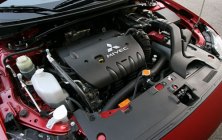 The mechanical aspects seems to be more promising. The new
platform rides on suspensions consisting of MacPherson struts up front
and multi-link setup at the rear. Such layout is a match for any rivals
of the class. The engine is also a huge improvement. The old Lancer
used to be powered by 1.5 and 1.8-liter engines. In contrast, the new
Lancer starts from a new 2-liter engine. Codenamed 4B11, this
all-aluminum unit is 27 kilograms lighter than the former iron-block
unit. It features DOHC 16V and continuous variable valve timing on both
camshafts (still called "MIVEC" but no variable lift here) to guarantee
good
power and wide spread of torque - some 152 horsepower and 146 lb-ft.
You might feel familiar with such specifications, because 4B11 was
developed jointly with Chrysler thus is also available in Dodge
Caliber. Another jointly developed "World Engine" to be debuted next
year is the 2.4-liter version, expected to produce 172 horses. The use
of at least 2-liter engines gives Mitsubishi a good reason to brand it
as Galant Fortis in Japan. The mechanical aspects seems to be more promising. The new
platform rides on suspensions consisting of MacPherson struts up front
and multi-link setup at the rear. Such layout is a match for any rivals
of the class. The engine is also a huge improvement. The old Lancer
used to be powered by 1.5 and 1.8-liter engines. In contrast, the new
Lancer starts from a new 2-liter engine. Codenamed 4B11, this
all-aluminum unit is 27 kilograms lighter than the former iron-block
unit. It features DOHC 16V and continuous variable valve timing on both
camshafts (still called "MIVEC" but no variable lift here) to guarantee
good
power and wide spread of torque - some 152 horsepower and 146 lb-ft.
You might feel familiar with such specifications, because 4B11 was
developed jointly with Chrysler thus is also available in Dodge
Caliber. Another jointly developed "World Engine" to be debuted next
year is the 2.4-liter version, expected to produce 172 horses. The use
of at least 2-liter engines gives Mitsubishi a good reason to brand it
as Galant Fortis in Japan.
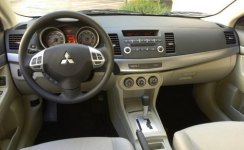 However, most of the extra power generated by 4B11 is
consumed by the heavy kerb weight and the INVECS-III Continuous
Variable Transmission. Motor Trend magazine found the CVT-equipped
Lancer GTS took 9.1 seconds to accelerate from 0 to 60 mph, which is
hardly impressive. Moreover, in automatic mode the INVECS-III CVT has
old fashioned rubber band effect to upset its driver. Of course, you
can always leave it in manual mode and use the 6-speed paddle shift to
improve its sluggish response, but a better solution is to choose the
5-speed manual gearbox instead. It would be more satisfying to use
while cutting 0-60 mph by a second. However, even so the Lancer doesn't
feel quick enough. However, most of the extra power generated by 4B11 is
consumed by the heavy kerb weight and the INVECS-III Continuous
Variable Transmission. Motor Trend magazine found the CVT-equipped
Lancer GTS took 9.1 seconds to accelerate from 0 to 60 mph, which is
hardly impressive. Moreover, in automatic mode the INVECS-III CVT has
old fashioned rubber band effect to upset its driver. Of course, you
can always leave it in manual mode and use the 6-speed paddle shift to
improve its sluggish response, but a better solution is to choose the
5-speed manual gearbox instead. It would be more satisfying to use
while cutting 0-60 mph by a second. However, even so the Lancer doesn't
feel quick enough.
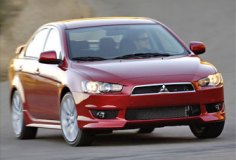 Mitsubishi's NVH engineering is not exactly world-class, so
despite of a huge improvement of chassis rigidity the firewall still
transfer too much engine noise into the cabin. On 18-inch wheels, the
suspensions feels firm and produces a fair amount of road noise on
bumpy roads. The
handling of Lancer is above average, but American motoring journalists
still prefer Mazda 3 and Honda Civic Si simply because they handle and
ride
better. The Mitsubishi's numb steering also leaves something to be
desired. Keen drivers would also beg for more power and more beautiful
sound from the engine. On the positive side, the Lancer offers good
grip, brakes and decent body control. Again, it is a huge improvement
from the outgoing car, but to match the best class rivals it needs to
work even better, obviously. Mitsubishi's NVH engineering is not exactly world-class, so
despite of a huge improvement of chassis rigidity the firewall still
transfer too much engine noise into the cabin. On 18-inch wheels, the
suspensions feels firm and produces a fair amount of road noise on
bumpy roads. The
handling of Lancer is above average, but American motoring journalists
still prefer Mazda 3 and Honda Civic Si simply because they handle and
ride
better. The Mitsubishi's numb steering also leaves something to be
desired. Keen drivers would also beg for more power and more beautiful
sound from the engine. On the positive side, the Lancer offers good
grip, brakes and decent body control. Again, it is a huge improvement
from the outgoing car, but to match the best class rivals it needs to
work even better, obviously.
Is that a big disappointment ? No, seeing how its sister car Caliber
performs, you won't expect it to be a new class leader anyway.
Nevertheless, we do expect a lot from the forthcoming GSR Evolution X.
Mitsubishi Lancer has always been mediocre in mass production form and
ultra-exciting in Evo form. Let's hope the same this time.
|
| The
above report was last updated on 15 Sep
2007. All Rights Reserved. |
European Lancer
|
| For
European market, the Lancer is equipped with smaller engines. Entry
level is the 109 hp 1.5-liter MIVEC engine from Colt. Next up is the
1.8-liter "World Engine" (see Dodge Caliber) rated at 143 hp. Besides,
there is a 140 hp 2.0-liter 16V turbo diesel engine sourced from
Volkswagen. The latter's superior real-world punch and frugality
explains why the 2.0 petrol is not offered in Europe.
|
| The
above report was last updated on 19 Sep
2007. All Rights Reserved. |
Lancer Ralliart
|
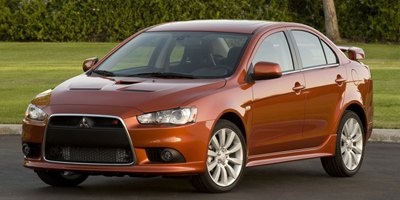
|
Want an Evo but think it too expensive
? Mitsubishi now offers a cheaper alternative.
|
What
is Lancer Ralliart ? You can see it as a downgrade from the mighty Evo
X, or an upgrade from the ordinary Lancer GTS. Mitsubishi combines the
bits of both to make a middle-price, medium hot model, so it finally
has a car to compete with Subaru Impreza WRX.
The Ralliart started life from the narrow-track chassis of regular
Lancer. Its all-steel suspensions are carried over from Lancer, albeit
with slightly stiffer setup and a stronger front tower bar. The brakes
are standard Lancer items except switching to 2-pot calipers up front.
The steering has retuned power assistance but it is no quicker than the
standard Lancer. The body shell is closer to the cheaper car as well,
although it gets a unique grille and an aluminum bonnet from Evo X.
In contrast to the chassis, the powertrain and running gears of
Ralliart are derived from Evo X. The 4B11 2.0-liter turbocharged engine
is detuned from 295 to 240 horsepower, 300 to 253 lb-ft of torque. This
is due to the use of a smaller single-scroll turbocharger, hence lower
boost pressure, a smaller intercooler and modified intake manifolds to
match the lower air flow. However, a less aggressive tuning means
nearly all the peak torque is available from 2500-4500 rpm, thus
provide good day-to-day drivability. Moreover, the detuned engine
produces
much less turbo lag. Of course, what you lose is the Evo X's explosive
power delivery, and 0-60 mph now takes around 6.5 seconds instead of 5
seconds. However, it goes well with WRX and Golf R32.
Surprisingly, Mitsubishi resisted the temptation of cost cutting and
decided to equip the Lancer Ralliart with a standard SST twin-clutch
transmission. It is basically the same as the Evo X's unit except
losing the most aggressive Super Sport mode and has revised ratios at
the top 2 gears to enhance fuel economy on highway. Considering how
good it works, SST gives the car a decisive edge over rivals (well,
Volkswagen Golf R32 has DSG as well, but Mitsubishi always consider
Subaru WRX as its arch-rival).
Fans of Mitsubishi will be glad to hear that Ralliart retains the Evo's
4-wheel-drive system and ACD active center differential. It saves some
money by ditching the AYC active yaw control at the rear axle and
replaces it with a mechanical LSD. This, together with the slower
steering rack, reduces its sharpness in tight corners and introduces
more understeer. Nevertheless,
such downgrade of handling is every bit predictable for a cheaper car.
What really hurts is the use of skinny 215/45R18 tires like Lancer GTS.
They produce much less grip on the dry and seriously hamper the
maneuverability of the car. The modest brakes also need upgrade
desperately.
With so many technology gadgets, the Lancer Ralliart is not going to be
cheap. Expect it will be close to the level of Golf R32, Audi S3, BMW
130i hatchback and 128i Coupe. All these are fast, capable and
high-quality cars. As long as it sticks to the skinny tires and weak
brakes, Ralliart will have limited appeal to the majority.
|
| The
above report was last updated on 19 Jun
2008. All Rights Reserved. |
Lancer Sportback
|
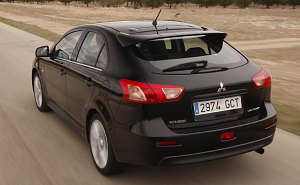
|
Straightforward conversion from sedan
to hatchback means a strange look
|
In
Europe, small saloons are far less popular than hatchbacks, therefore
for European market Mitsubishi now offers a hatchback version of Lancer
called "Lancer Sportback". The conversion from 3-box to 2-box body is
straightforward, so straightforward that it looks like designed by
engineers instead of stylists. I have no problem with a fast-angle
tailgate (think about the original Lancia Delta), but when a fast-angle
tailgate meets a long bonnet and a long front overhang, it means a
nose-heavy proportion, which is not as sporty as its name suggested.
Besides, the shape of its rear window, taillights and roof spoiler also
look rather odd, actually damaged the original design.
Quite unbelievably, the hatchback is actually 15 mm longer than the
sedan. It should provide as much luggage space, but unfortunately it
manages only 288-344 liters (depending on the height of parcel shelf),
compare with 400 liters of Lancer sedan. Nevertheless, its rear seat
can fold flat to release 1349 liters, something the sedan cannot match.
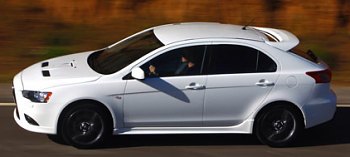
|
Ralliart version powered by 240hp
engine
|
The
European car is powered by 3 engines - At the bottom is the 109hp
1.5-liter MIVEC (from Colt). Then there is a Volkswagen-sourced 2.0
turbo diesel with 140hp, expected to be best seller. On the top is the
Ralliart version, which is powered by a 240hp 2.0 turbo like the
US-market Ralliart sedan recently reported. Its 4WD hardware and
running gears are also the same as the Ralliart sedan, so it shares
that car's average dynamics.
Lancer Sportback is not a bad car, but it does not stand out from the
crowd in any area. There are many European hatchbacks offer better made
cabin, better refinement or better dynamics, while most of them look
prettier. European don't need to turn to the Japanese for a hatchback.
|
| The
above report was last updated on 25 Jun
2008. All Rights Reserved. |
Lancer Evo X
|
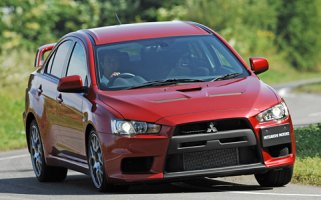
|
Evo X is slower than the previous car
in straight line, but hopefully its stronger handling will claw back
the lost ground...
|
Amazingly, it took only 15
years
to go from the first Lancer Evolution to Evo X. If you are not familiar
with the history of Evo, it doesn't matter, you may read the article
"Evolution of Evo" below or our previous report for Evo VII to Evo IX
in the "Graveyard" section. Looking through the evolution of this car
is interesting, as you will find how it got bigger, more powerful and
more sophisticated in the process. However, Evo X is a big departure
from the previous 9 evolutions. For the first time in its history, it
gets an all-new chassis, engine and gearbox at the same time. In other
words, it is virtually a brand new car. Should we still call it an
Evolution ? or maybe Revolution a better description ?
As most of you know, Evo X is built on the new generation Lancer
platform sharing with various Chrysler products. Compare with the last
Evo IX, it is slightly longer, much wider, much taller and much much
stiffer – 39 percent stronger in torsion and 64 percent stiffer in
bending. The extra rigidity benefits handling as well as refinement,
but an inevitable by-product is 130 kg of extra weight. That accounts
for almost 10 percent of the overall weight and adds considerable
strain to the engine.
Part of the weight increment is compensated with a stronger engine.
Codenamed 4B11, it replaces the long-serving 4G63 engine which has been
around since the beginning of the Evo series. Governed by rallying
rules, 4B11 is still a 2.0-liter four-cylinder engine with a single
turbocharger. Its construction, however, is much more advanced than the
old one. First of all, the engine has an aluminum block to save some 12
kg from the nose to help chassis balance. Secondly, it gets MIVEC
intake and exhaust variable cam phasing to improve low to mid range
torque (Evo IX had MIVEC on intake camshaft only). Thirdly, power
output is improved by relocating the exhaust manifolds. Previously, the
exhaust manifolds of 4G63 were forward-facing and routed backward
underneath the engine; Now 4B11 has its exhaust faces rearward and goes
straight towards the silencer, thus the gas flow runs shorter and
smoother and generates less back pressure. Fourthly, as the engine no
longer has exhaust pipes running underneath it, it can be mounted lower
to improve center of gravity.
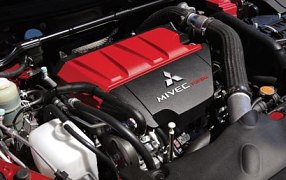
|
The new aluminum-block engine is
smoother and has a better power band. But the progress it made is not
revolutionary...
|
As before, the turbine is made of
titanium-aluminum alloy to
compensate for its large size – something necessary to achieve a
specific output over 140 horsepower per liter. Officially speaking, Evo
X is still bounded by the (silly) 280 ps domestic voluntary limit
(Subaru no longer follows that in its new Impreza STi), but no one
actually believes that. Considering Evo VIII was known to produce
around 310 horses, the actual output of Evo X could only be higher. How
much higher is difficult to say, but the unrestricted torque figure may
give you some hints – it produces 311 lbft at 3500 rpm, compare with
295 lbft of the last generation car. The torque curve is also
noticeably flatter than before.
Furthermore, the new Evo has its 6-speed manual gearbox replaced by a
new dual-clutch gearbox called SST (note: at the same time a 5-speed
manual is offered as a cheaper alternative). As most of you know,
dual-clutch gearbox is the future of our gearboxes. It employs one
clutch to engage the odd gears and another clutch to engage the even
gears. In this way, it is capable to pre-select the next gear while the
current gear is still engaged. Once the driver make the shift, the
current clutch disengages and at the same time the other clutch
engages, thus the next gear gets into effect immediately and smoothly.
Dual-clutch gearbox was first introduced to Audi TT in 2003 and so far
only the Volkswagen group enjoys its service. However, it will be
increasingly popular in the next few years, as it will appear in Evo X,
Nissan GT-R, Ford Focus, Porsche 911… In the Evo X, the SST gearbox
provides 3 operating modes – normal, sport and super sport – for the
driver to select. Of course, normal is the smoothest while super sport
is the fastest.
These improvements should help clawing back some of the lost
performance. Nevertheless, a kerb weight of 1540 kg is too much to
bear. On the road, the Evo X's engine feels smoother, calmer and less
explosive in the mid-range than the previous 4G63. Car and Driver found
it took 5.0 seconds to accelerate from 0-60 mph and 13.4 seconds to 100
mph, while Road & Track recorded similar figures. Such performance
may be outstanding for the class, but they can't match the old car's
4.6 and 11.9 seconds respectively. It will also slip behind the new
Subaru Impreza WRX STi, which is equally powerful but some 60 kg
lighter. This must be a big disappointment to its fans.
In fact, since Evo V, the Evo series has not really got any faster.
Dictated by the rule of 2-liter single-turbo engine, Mitsubishi could
barely achieve a slight power boost each generation to offset the
weight increment necessary for improving handling and safety. Had the
engine got more capacity and/or a twin-turbo system, or even better
direct-injection and two-stage twin-turbo, it would have produced extra
power more easily. When a car is developed to the extreme, it is time
to rethink its formula and pursue a bigger revolution. Unfortunately,
Evo X was developed when Mitsubishi had serious financial trouble, so
it lack a far-sighted vision.
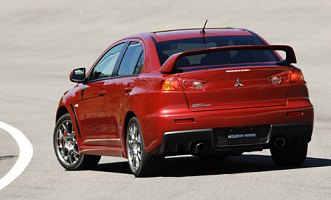
|
The hardwares of ACD, AYC, ASC and ABS
are mostly the same as before, yet the integration among them results
in much better control. It is a matter of tireless testing and software
works.
|
On a winding road, however, Evo X is quicker than any previous
generations. This is because its improved chassis and traction allow
higher cornering speed and more accurate control. In Evo IX, the driver
wasted time to fight with road irregularities and under/oversteer by
correcting the steering and adjusting throttle. This might be hugely
exciting to some hardcore drivers, but it did not produce the same lap
time as Evo X, nor did it deliver the same driving confidence. In
contrast, Evo X runs faster in corner yet feels calmer and easier. Its
rigid chassis and longer wheelbase cope better with bumps, resulting in
a smoother ride. Its wider footprints, wider tracks and lower center of
gravity allows it go quicker in bends. Its better front-to-rear weight
distribution (due to the lighter engine and by moving the battery to
the trunk) contributes to a more neutral cornering attitude. Its
steering is less influenced by road irregularities, although some may
regard that as less communicative.
The enhanced traction system is equally effective as the improved
chassis. As before, Evo X employs an electronic-controlled Active
Center Differential (ACD) to distribution power between front and rear
wheels. It also has Active Yaw Control (AYC) to distribute power
between the rear wheels to correct under/oversteer. Also like before,
the ACD and AYC offer 3 modes, Tarmac, Gravel and Snow, for different
front-rear bias characteristics. However, for the first time the
control system of ACD and AYC integrates with ASC stability control and
ABS to form what Mitsubishi called S-AWC (Super All-Wheel Control).
From hardware point of view it seems nothing revolutionary, but on the
road the better integrated system results in vast improvements in grip
and stability because it covers virtually all the situations the driver
may encounter. Storm the Evo X on twisty roads at terrific speed and
you will find the car sort itself out beautifully. You don't need to
apply opposite locks to correct its line. It simply goes where you
point.
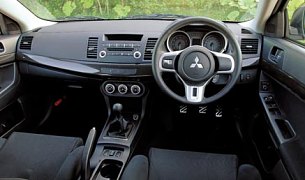
|
More space, ride comfort and
refinement makes Evo X closer to the previous BMW M3. However, interior
quality is no BMW.
|
Some of you may find the Evo X not as
involving and
thrilling to drive as the previous car, because its power is less
explosive, because its chassis is more competent and, sorry, because
its electronic brain is cleverer than yours. In fact, jumping from a
1962 Ferrari 250 GTO into today's 599 GTB will probably give the same
feelings. This is an inevitable development trend.
Undoubtedly, Evo X is a better A-to-B car than ever – it is faster
point to point; it is far easier to drive; it is more refined and more
accommodative. To some extent it gets closer to the territory of the
previous generation BMW M3 while retaining its all-weather / all-road
ability. Its faults are minor – its styling is a quite raw, its
interior is a little cheap, it could be lighter and more powerful… but
keen drivers can easily forgive them. As before, the Evo X has no
direct rival except Subaru Impreza STI. Now it is the turn of Subaru to
respond.
Evo X GSR and RS
As before, the Evo X is available in two models: the road-going GSR and
the race-biased RS. The RS is 100 kg lighter due to a bare cabin,
5-speed gearbox, 16-inch wheels shod with 205/60 tires and the lack of
rear spoiler, therefore it is also significantly cheaper. The GSR has
all kinds of equipment, delicious Recaro seats and 18-inch wheels shod
with 245/40 tires. It is also the standard car Mitsubishi offers to
most markets. |
| The
above report was last updated on 31 Oct
2007. All Rights Reserved. |
Evolution of Evo: from Evo I to Evo X
|
Since
the first Lancer Evolution arrived in 1992, it kept updating nearly
every year. The Evolution I
was already a spectacular car, with the 4G63 turbocharged 16 valves
straight four engine pumping out 250hp, 4-wheel-drive, aluminium
bonnet, close ratio gearbox, Recaro sports seats and Momo steering
wheels...
Evo II launched in
late
1993, had little modifications, the most important of which is the
increment of ride height to provide more suspensions travel. The engine
got 10 extra horsepower.
Evo III in Jan 95
introduced a set of awesome aerodynamic kits, including big front
bumper and bi-plane rear wing. Intercooler was enlarged while power
raised to 270hp.
Evo IV of summer 96
was
based on the body of the new generation Lancer sedan. Apart from the
stronger chassis, a lot effort was made to the engine and drive train.
Racing camshaft, improved induction and exhaust added 10 hp and more
important, 33 lbft of torque. Helical mechanical rear LSD was used
while the AYC Automatic Yaw Control made its debut.
Evo V of Jan 98 was
also
another great improvement. Front and rear track received a generous
increment of 40 and 35mm respectively. Wider wheel arches accommodate
the 225mm wide, 17in diameter sports tyres. Superior brakes
incorporated Brembo calipers with 4 pistons in front and 2 in rear.
Suspensions arms made of aluminium alloy. Inverted dampers improved
chassis rigidity. A new turbocharger and improved intercooler brought
peak torque to 275lbft from 261lbft, while the 280hp power was bounded
by domestic regulation. An improved AYC reduced the understeer found in
previous generations so that many people started to choose the Lancer
instead of Subaru Impreza WRX.
Evo VI of Jan 99
improved
mostly in aerodynamics reacted to the change of WRC's regulation, plus
improved engine cooling making the same power and torque more durable.
RS version introduced the world's first titanium turbine to reduce
turbo lag. Extra spot welds improved chassis rigidity.
Late 99 introduced Tommi Makinen
edition of Evo VI as a celebration to
the driver's 4th consecutive WRC title with Mitsubishi. Cosmetic
changes aside, there are some minor tweaks - ride height dropped 10mm
(therefore ride even harsher), revised Titanium turbine to improve
response, more engine cooling, larger exhaust diameter and improved oil
pant.
Evo VII of year
2001 was
derived from the new generation Lancer. The car was larger and heavier.
The 4G63 engine received minor modifications like hollow camshafts,
smaller turbine nozzle (to improve response), higher flow intercooler
with water spray, a bigger oil cooler and a variable back-pressure
exhaust. It produced 7 more lbft of torque while officially the max
power is still 280hp. However, the most important change is the 4WD
system - now with electronic-controlled active center differential
(ACD) in combination with AYC. Handling was much improved as a result.
Evo VIII of 2003
was a
small evolution - torque increased by 7 lbft again, gearbox upgraded to
a 6-speed unit and a longer nose enabled the compliance with US Federal
safety requirements.
The US market version of Evo VIII was simply called "Lancer Evolution".
It was 70 kg heavier due to the addition of anti-intrusion bar added to
the nose. Emission regs dragged down its power to 271hp, so it was
slower than the Japanese version. Worse still, the ACD and AYC were
replaced by a viscous coupling and a mechanical LSD respectively in
order to save costs.
By mid-2004, Evo VIII MR was
launched as a minor revision. The turbo system was tuned to deliver
more torque. The roof was converted to aluminum to lower center of
gravity. Lighter wheels and door protection beam also contributed to
less weight. Bilstein dampers improved ride a little. The ACD and AYC
were reprogrammed to intrude less with ABS.
2005 saw Evo IX, the last one
built on the contemporary Lancer chassis and the 4G63 engine. The
latter added MIVEC intake variable valve timing and, accompany with yet
another fine tuning of the turbocharging system, produced more torque
and a flatter torque curve. Like the previous MR, the roof was made of
aluminum. The rear spoiler was made of hollow carbon-fiber.
Comparing with the above evolutions, Evo
X is a major update, wth all-new chassis, engine and gearbox. It
has no relationship with the first Evo any more.
Model
|
Year
|
Length
|
Width
|
Height
|
Wheelbase
|
Weight
|
Power
|
Torque
|
Tyres
|
Evo I
|
1992
|
4310 mm
|
1695 mm
|
1395 mm
|
2500 mm
|
1240 kg
|
250 hp
|
228 lbft
|
195/55R15
|
Evo II
|
1993
|
4310 mm
|
1695 mm |
1420 mm
|
2510 mm
|
1250 kg
|
260 hp
|
228 lbft |
205/55R16
|
Evo III
|
1995
|
4310 mm
|
1695 mm |
1420 mm
|
2510 mm |
1260 kg
|
270 hp
|
228 lbft |
205/55R16 |
Evo IV
|
1996
|
4330 mm
|
1690 mm |
1415 mm
|
2510 mm |
1350 kg
|
280 hp
|
261 lbft |
205/55R16 |
Evo V
|
1998
|
4350 mm
|
1770 mm
|
1415 mm |
2510 mm |
1360 kg
|
280 hp |
275 lbft
|
225/45R17 |
Evo VI
|
1999
|
4350 mm
|
1770 mm
|
1415 mm |
2510 mm |
1360 kg
|
280 hp |
275 lbft
|
225/45R17 |
Evo VII
|
2001
|
4455 mm
|
1770 mm
|
1450 mm
|
2625 mm
|
1400 kg
|
280 hp |
282 lbft
|
235/45R17
|
Evo VIII
|
2003
|
4490 mm
|
1770 mm
|
1450 mm
|
2625 mm
|
1410 kg
|
280 hp |
289 lbft
|
235/45R17
|
Evo IX
|
2005
|
4490 mm
|
1770 mm
|
1450 mm
|
2625 mm
|
1410 kg
|
280 hp |
295 lbft
|
235/45R17
|
Evo X
|
2007
|
4495 mm
|
1810 mm
|
1480 mm
|
2650 mm
|
1540 kg
|
280 hp |
311 lbft
|
245/45R18
|
|
| The
above report was last updated on 24 Oct
2007. All Rights Reserved. |
|
|